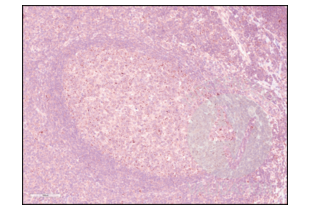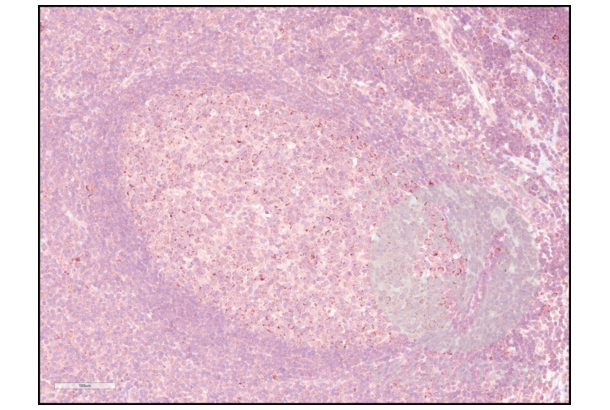PD-1 Antibodies

 PD-1 antibody (AA 201-288) (ABIN735608)
PD-1 antibody (AA 201-288) (ABIN735608)
PDCD1 Reactivity: Human, Mouse, Rat FACS, WB, ELISA, IHC (p), IHC (fro), IF (cc), IF (p) Host: Rabbit Polyclonal unconjugated
PDCD1 Reactivity: Human WB, ELISA, IHC (p), ICC, IHC (fro) Host: Rabbit Polyclonal unconjugated
PDCD1 Reactivity: Human FACS, WB, ELISA Host: Mouse Monoclonal 8G5B12 unconjugated
PD-1 Antibodies by Grade
Find PD-1 Antibodies with a specific Grade. The Grade listed below are among those available. Click on a link to go to the corresponding products.
PD-1 Antibodies by Reactivity
Find PD-1 Antibodies for a variety of species such as anti-Human PD-1, anti-Mouse PD-1, anti-Rat PD-1. The species listed below are among those available. Click on a link to go to the corresponding products.
PD-1 Antibodies by Host
Find PD-1 Antibodies with a specific Host. The Host listed below are among those available. Click on a link to go to the corresponding products.
PD-1 Antibodies by Clonality
Find available monoclonal or polyclonal PD-1 Antibodies. Click on a link to go to the corresponding products.
PD-1 Antibodies by Fragment
Find PD-1 Antibodies with a specific Fragment. The Fragment listed below are among those available. Click on a link to go to the corresponding products.
Popular PD-1 Antibodies
- (2)
- (3)
- (1)
- (8)
- (5)
- (5)
- (4)
- (4)
- (3)
- (3)
- (3)
- (2)
- (2)
- (2)
- (2)
- (2)
- (2)
Latest Publications for our PD-1 Antibodies
: "Evaluation of costimulatory molecules in dogs with B cell high grade lymphoma." in: PLoS ONE, Vol. 13, Issue 7, pp. e0201222, (2019) (PubMed).: "Immune Activation and Benefit From Avelumab in EBV-Positive Gastric Cancer." in: Journal of the National Cancer Institute, Vol. 110, Issue 3, pp. 316-320, (2019) (PubMed).
: "Low levels of SIV-specific CD8+ T cells in germinal centers characterizes acute SIV infection." in: PLoS pathogens, Vol. 15, Issue 3, pp. e1007311, (2019) (PubMed).
: "Tumor-derived exosomal HMGB1 promotes esophageal squamous cell carcinoma progression through inducing PD1+ TAM expansion." in: Oncogenesis, Vol. 8, Issue 3, pp. 17, (2019) (PubMed).
: "IL-17C-mediated innate inflammation decreases the response to PD-1 blockade in a model of Kras-driven lung cancer." in: Scientific reports, Vol. 9, Issue 1, pp. 10353, (2019) (PubMed).
: "Hepatic expression of programmed death-1 (PD-1) and its ligand, PD-L1, in children with autoimmune hepatitis: relation to treatment response." in: Clinical and experimental hepatology, Vol. 5, Issue 3, pp. 256-264, (2019) (PubMed).
: "Non-conventional Inhibitory CD4+Foxp3-PD-1hi T Cells as a Biomarker of Immune Checkpoint Blockade Activity." in: Cancer cell, Vol. 33, Issue 6, pp. 1017-1032.e7, (2019) (PubMed).
: "Genome-wide genetic and epigenetic analyses of pancreatic acinar cell carcinomas reveal aberrations in genome stability." in: Nature communications, Vol. 8, Issue 1, pp. 1323, (2018) (PubMed).
: "89Zr-labeled nivolumab for imaging of T-cell infiltration in a humanized murine model of lung cancer." in: European journal of nuclear medicine and molecular imaging, Vol. 45, Issue 1, pp. 110-120, (2018) (PubMed).
: "Quantitative Multiplexed Imaging Analysis Reveals a Strong Association between Immunogen-Specific B Cell Responses and Tonsillar Germinal Center Immune Dynamics in Children after Influenza ..." in: Journal of immunology (Baltimore, Md. : 1950), Vol. 200, Issue 2, pp. 538-550, (2018) (PubMed).
Aliases for PD-1 Antibodies
programmed cell death 1 (PDCD1) Antibodiesprogrammed cell death 1 (Pdcd1) Antibodies
CD279 Antibodies
hPD-1 Antibodies
hPD-l Antibodies
Ly101 Antibodies
PD-1 Antibodies
PD1 Antibodies
Pdc1 Antibodies
SLEB2 Antibodies
Did you look for something else?
- PCYT2 Antibodies
- PCYOX1L Antibodies
- PCYOX1 Antibodies
- PCTP Antibodies
- PCSK9 Antibodies
- PCSK7 Antibodies
- PCSK6 Antibodies
- PCSK5 Antibodies
- PCSK4 Antibodies
- PCSK2 Antibodies
- PCSK1N Antibodies
- PCSK1 Antibodies
- PCP4 Antibodies
- Pcp2 Antibodies
- PCOTH Antibodies
- PCOLCE2 Antibodies
- PCOLCE Antibodies
- PCNXL2 Antibodies
- PCNT Antibodies
- PCNP Antibodies
- PD-L1 Antibodies
- PDAP1 Antibodies
- PDCD11 Antibodies
- PDCD1LG2 Antibodies
- PDCD2 Antibodies
- PDCD2L Antibodies
- PDCD5 Antibodies
- PDCD6 Antibodies
- PDCD7 Antibodies
- PDCL2 Antibodies
- PDCL3 Antibodies
- PDE10A Antibodies
- PDE11A Antibodies
- PDE12 Antibodies
- PDE1A Antibodies
- PDE1B Antibodies
- PDE1C Antibodies
- PDE2A Antibodies
- PDE3A Antibodies
- PDE3B Antibodies




